Blog Writing Assignment: Atomic Numbers and Periodic Table Elements
VerifiedAdded on 2019/09/30
|6
|1427
|323
Essay
AI Summary
This blog post provides a comprehensive overview of atomic numbers and the periodic table. It begins by defining atomic numbers and their significance in distinguishing elements, explaining that each element has a unique atomic number corresponding to the number of protons in its nucleus. The post then delves into the history of the periodic table, tracing its evolution from early attempts by Lavoisier to the modern table developed by Mendeleev, highlighting key milestones such as the Law of Triads and the helix format. The blog further details the structure of the periodic table, including groups, periods, and blocks, explaining how elements are organized and how their properties change within the table. It also classifies elements into metals, nonmetals, and metalloids, outlining their distinct characteristics. Finally, the post touches on different types of periodic tables, such as the long table and Benfey’s spiral table, offering a glimpse into alternative representations of element organization.

Running Head: Blog writing
Blog writing
Blog writing
Paraphrase This Document
Need a fresh take? Get an instant paraphrase of this document with our AI Paraphraser
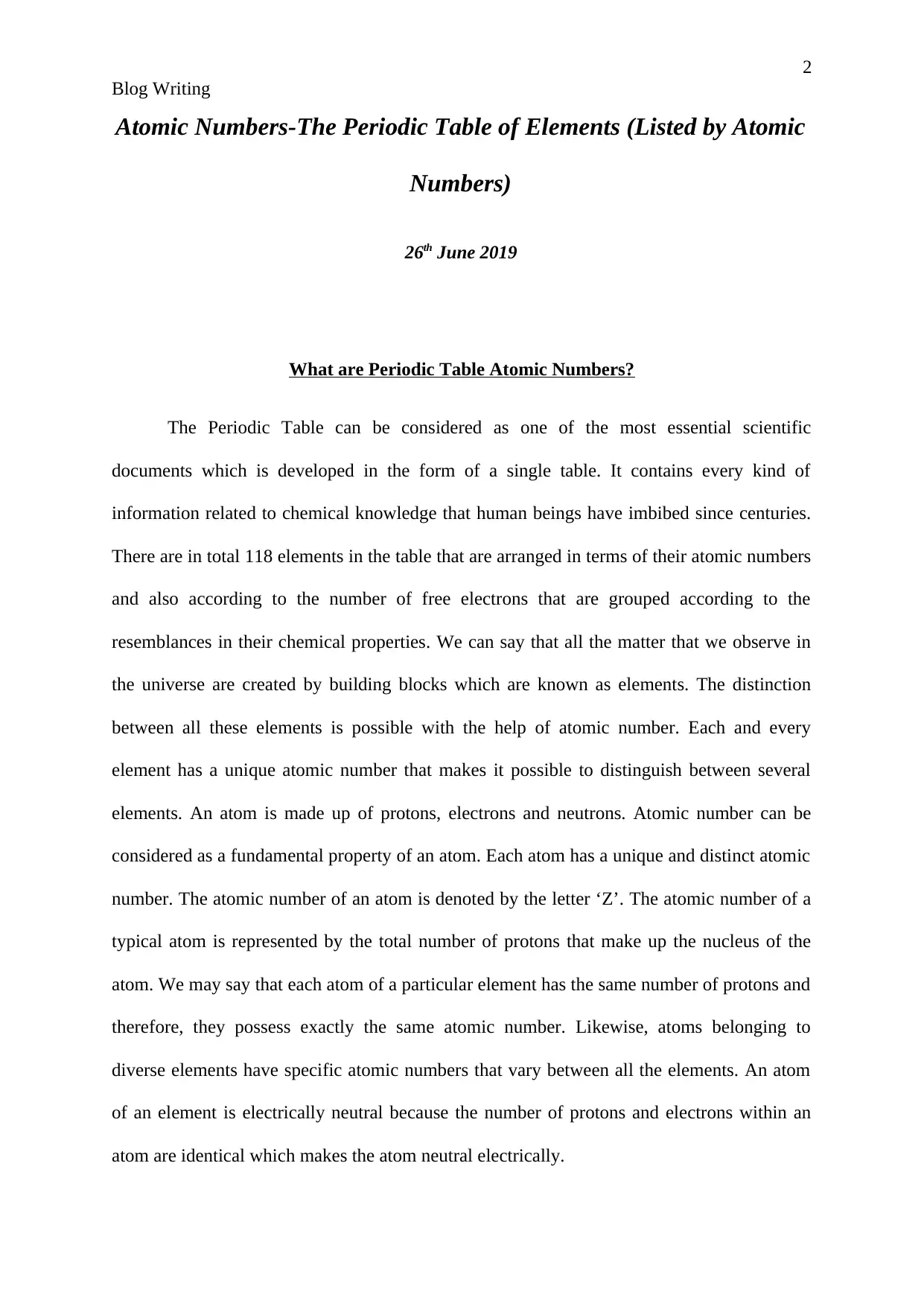
2
Blog Writing
Atomic Numbers-The Periodic Table of Elements (Listed by Atomic
Numbers)
26th June 2019
What are Periodic Table Atomic Numbers?
The Periodic Table can be considered as one of the most essential scientific
documents which is developed in the form of a single table. It contains every kind of
information related to chemical knowledge that human beings have imbibed since centuries.
There are in total 118 elements in the table that are arranged in terms of their atomic numbers
and also according to the number of free electrons that are grouped according to the
resemblances in their chemical properties. We can say that all the matter that we observe in
the universe are created by building blocks which are known as elements. The distinction
between all these elements is possible with the help of atomic number. Each and every
element has a unique atomic number that makes it possible to distinguish between several
elements. An atom is made up of protons, electrons and neutrons. Atomic number can be
considered as a fundamental property of an atom. Each atom has a unique and distinct atomic
number. The atomic number of an atom is denoted by the letter ‘Z’. The atomic number of a
typical atom is represented by the total number of protons that make up the nucleus of the
atom. We may say that each atom of a particular element has the same number of protons and
therefore, they possess exactly the same atomic number. Likewise, atoms belonging to
diverse elements have specific atomic numbers that vary between all the elements. An atom
of an element is electrically neutral because the number of protons and electrons within an
atom are identical which makes the atom neutral electrically.
Blog Writing
Atomic Numbers-The Periodic Table of Elements (Listed by Atomic
Numbers)
26th June 2019
What are Periodic Table Atomic Numbers?
The Periodic Table can be considered as one of the most essential scientific
documents which is developed in the form of a single table. It contains every kind of
information related to chemical knowledge that human beings have imbibed since centuries.
There are in total 118 elements in the table that are arranged in terms of their atomic numbers
and also according to the number of free electrons that are grouped according to the
resemblances in their chemical properties. We can say that all the matter that we observe in
the universe are created by building blocks which are known as elements. The distinction
between all these elements is possible with the help of atomic number. Each and every
element has a unique atomic number that makes it possible to distinguish between several
elements. An atom is made up of protons, electrons and neutrons. Atomic number can be
considered as a fundamental property of an atom. Each atom has a unique and distinct atomic
number. The atomic number of an atom is denoted by the letter ‘Z’. The atomic number of a
typical atom is represented by the total number of protons that make up the nucleus of the
atom. We may say that each atom of a particular element has the same number of protons and
therefore, they possess exactly the same atomic number. Likewise, atoms belonging to
diverse elements have specific atomic numbers that vary between all the elements. An atom
of an element is electrically neutral because the number of protons and electrons within an
atom are identical which makes the atom neutral electrically.
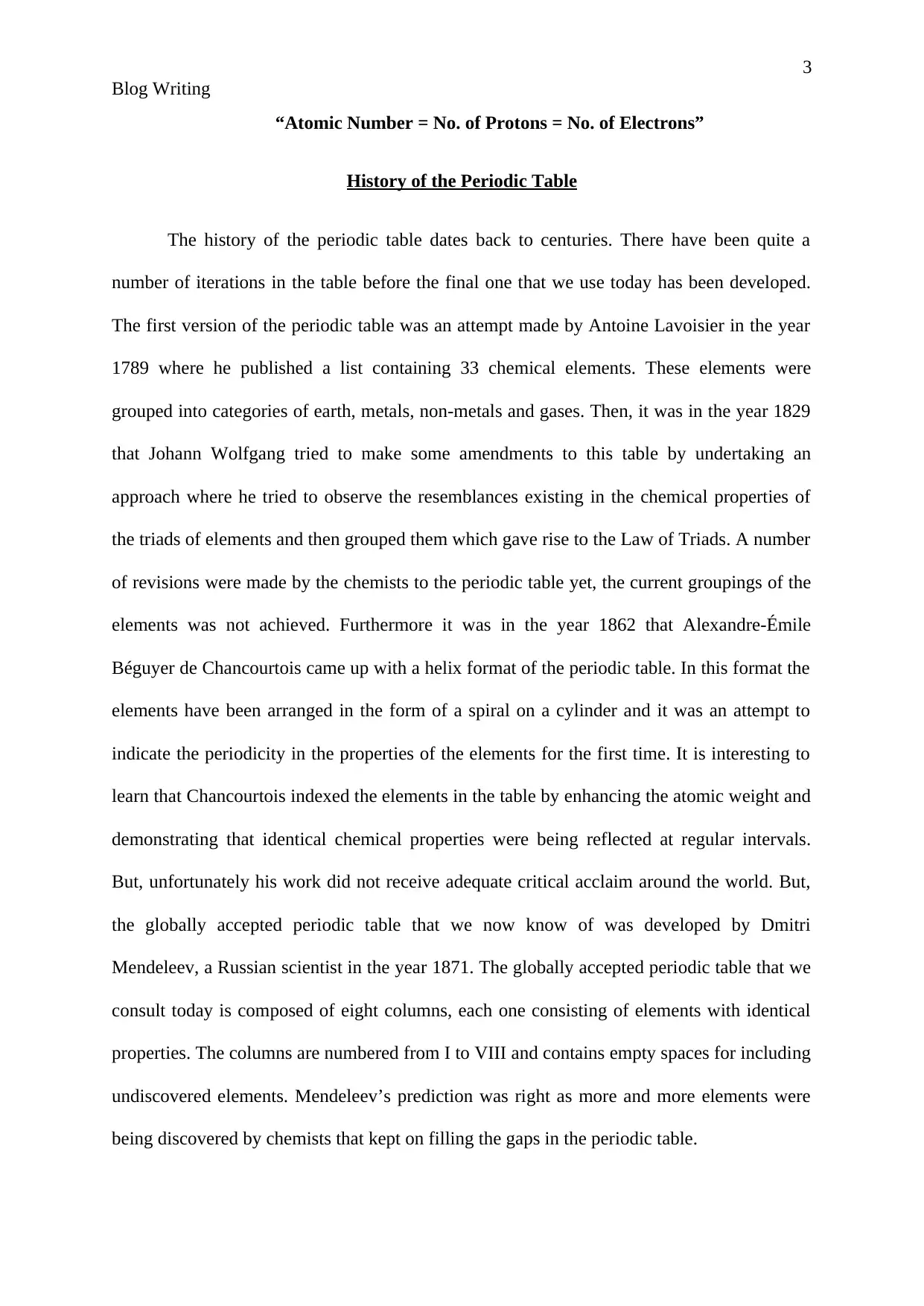
3
Blog Writing
“Atomic Number = No. of Protons = No. of Electrons”
History of the Periodic Table
The history of the periodic table dates back to centuries. There have been quite a
number of iterations in the table before the final one that we use today has been developed.
The first version of the periodic table was an attempt made by Antoine Lavoisier in the year
1789 where he published a list containing 33 chemical elements. These elements were
grouped into categories of earth, metals, non-metals and gases. Then, it was in the year 1829
that Johann Wolfgang tried to make some amendments to this table by undertaking an
approach where he tried to observe the resemblances existing in the chemical properties of
the triads of elements and then grouped them which gave rise to the Law of Triads. A number
of revisions were made by the chemists to the periodic table yet, the current groupings of the
elements was not achieved. Furthermore it was in the year 1862 that Alexandre-Émile
Béguyer de Chancourtois came up with a helix format of the periodic table. In this format the
elements have been arranged in the form of a spiral on a cylinder and it was an attempt to
indicate the periodicity in the properties of the elements for the first time. It is interesting to
learn that Chancourtois indexed the elements in the table by enhancing the atomic weight and
demonstrating that identical chemical properties were being reflected at regular intervals.
But, unfortunately his work did not receive adequate critical acclaim around the world. But,
the globally accepted periodic table that we now know of was developed by Dmitri
Mendeleev, a Russian scientist in the year 1871. The globally accepted periodic table that we
consult today is composed of eight columns, each one consisting of elements with identical
properties. The columns are numbered from I to VIII and contains empty spaces for including
undiscovered elements. Mendeleev’s prediction was right as more and more elements were
being discovered by chemists that kept on filling the gaps in the periodic table.
Blog Writing
“Atomic Number = No. of Protons = No. of Electrons”
History of the Periodic Table
The history of the periodic table dates back to centuries. There have been quite a
number of iterations in the table before the final one that we use today has been developed.
The first version of the periodic table was an attempt made by Antoine Lavoisier in the year
1789 where he published a list containing 33 chemical elements. These elements were
grouped into categories of earth, metals, non-metals and gases. Then, it was in the year 1829
that Johann Wolfgang tried to make some amendments to this table by undertaking an
approach where he tried to observe the resemblances existing in the chemical properties of
the triads of elements and then grouped them which gave rise to the Law of Triads. A number
of revisions were made by the chemists to the periodic table yet, the current groupings of the
elements was not achieved. Furthermore it was in the year 1862 that Alexandre-Émile
Béguyer de Chancourtois came up with a helix format of the periodic table. In this format the
elements have been arranged in the form of a spiral on a cylinder and it was an attempt to
indicate the periodicity in the properties of the elements for the first time. It is interesting to
learn that Chancourtois indexed the elements in the table by enhancing the atomic weight and
demonstrating that identical chemical properties were being reflected at regular intervals.
But, unfortunately his work did not receive adequate critical acclaim around the world. But,
the globally accepted periodic table that we now know of was developed by Dmitri
Mendeleev, a Russian scientist in the year 1871. The globally accepted periodic table that we
consult today is composed of eight columns, each one consisting of elements with identical
properties. The columns are numbered from I to VIII and contains empty spaces for including
undiscovered elements. Mendeleev’s prediction was right as more and more elements were
being discovered by chemists that kept on filling the gaps in the periodic table.
⊘ This is a preview!⊘
Do you want full access?
Subscribe today to unlock all pages.

Trusted by 1+ million students worldwide
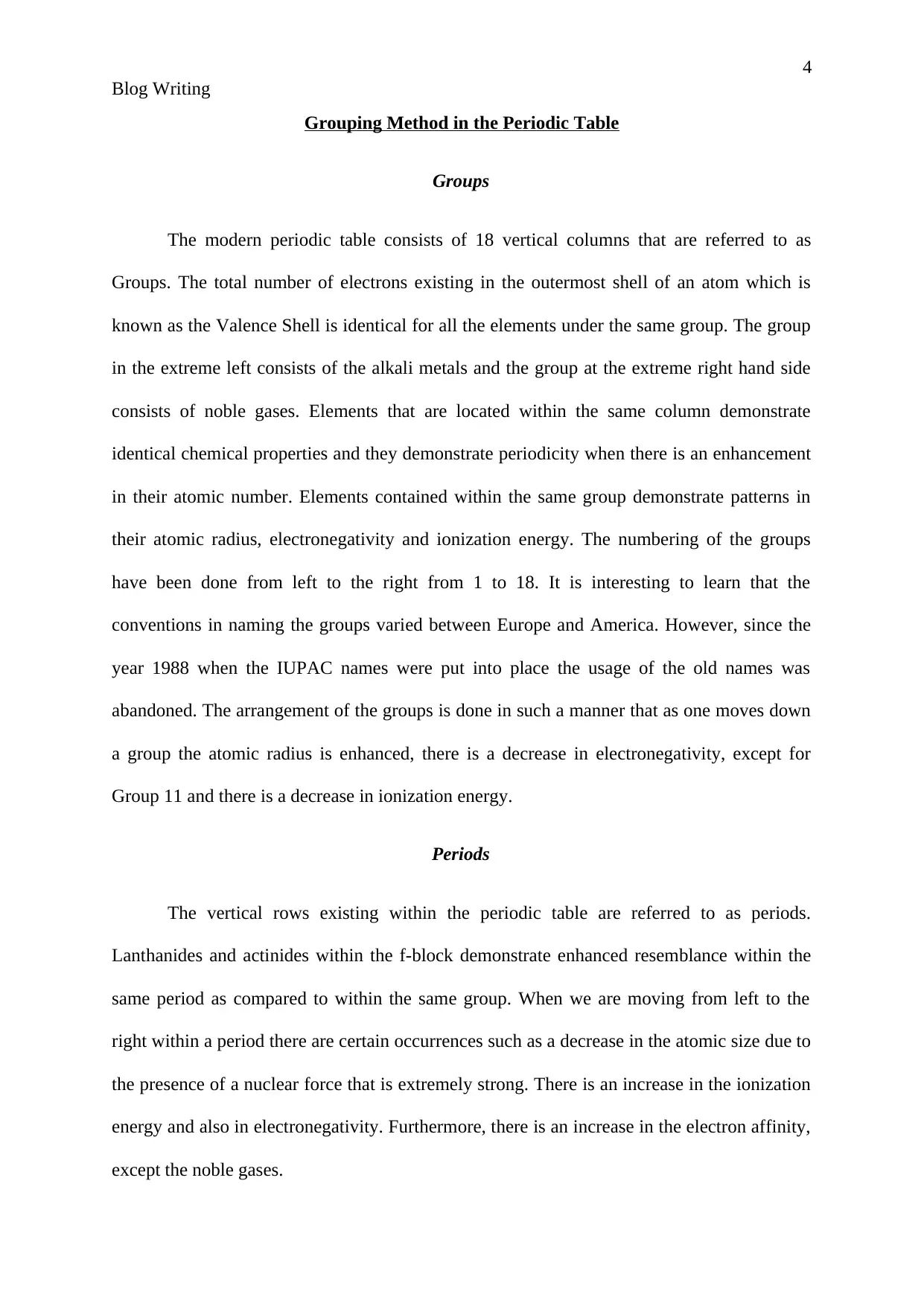
4
Blog Writing
Grouping Method in the Periodic Table
Groups
The modern periodic table consists of 18 vertical columns that are referred to as
Groups. The total number of electrons existing in the outermost shell of an atom which is
known as the Valence Shell is identical for all the elements under the same group. The group
in the extreme left consists of the alkali metals and the group at the extreme right hand side
consists of noble gases. Elements that are located within the same column demonstrate
identical chemical properties and they demonstrate periodicity when there is an enhancement
in their atomic number. Elements contained within the same group demonstrate patterns in
their atomic radius, electronegativity and ionization energy. The numbering of the groups
have been done from left to the right from 1 to 18. It is interesting to learn that the
conventions in naming the groups varied between Europe and America. However, since the
year 1988 when the IUPAC names were put into place the usage of the old names was
abandoned. The arrangement of the groups is done in such a manner that as one moves down
a group the atomic radius is enhanced, there is a decrease in electronegativity, except for
Group 11 and there is a decrease in ionization energy.
Periods
The vertical rows existing within the periodic table are referred to as periods.
Lanthanides and actinides within the f-block demonstrate enhanced resemblance within the
same period as compared to within the same group. When we are moving from left to the
right within a period there are certain occurrences such as a decrease in the atomic size due to
the presence of a nuclear force that is extremely strong. There is an increase in the ionization
energy and also in electronegativity. Furthermore, there is an increase in the electron affinity,
except the noble gases.
Blog Writing
Grouping Method in the Periodic Table
Groups
The modern periodic table consists of 18 vertical columns that are referred to as
Groups. The total number of electrons existing in the outermost shell of an atom which is
known as the Valence Shell is identical for all the elements under the same group. The group
in the extreme left consists of the alkali metals and the group at the extreme right hand side
consists of noble gases. Elements that are located within the same column demonstrate
identical chemical properties and they demonstrate periodicity when there is an enhancement
in their atomic number. Elements contained within the same group demonstrate patterns in
their atomic radius, electronegativity and ionization energy. The numbering of the groups
have been done from left to the right from 1 to 18. It is interesting to learn that the
conventions in naming the groups varied between Europe and America. However, since the
year 1988 when the IUPAC names were put into place the usage of the old names was
abandoned. The arrangement of the groups is done in such a manner that as one moves down
a group the atomic radius is enhanced, there is a decrease in electronegativity, except for
Group 11 and there is a decrease in ionization energy.
Periods
The vertical rows existing within the periodic table are referred to as periods.
Lanthanides and actinides within the f-block demonstrate enhanced resemblance within the
same period as compared to within the same group. When we are moving from left to the
right within a period there are certain occurrences such as a decrease in the atomic size due to
the presence of a nuclear force that is extremely strong. There is an increase in the ionization
energy and also in electronegativity. Furthermore, there is an increase in the electron affinity,
except the noble gases.
Paraphrase This Document
Need a fresh take? Get an instant paraphrase of this document with our AI Paraphraser
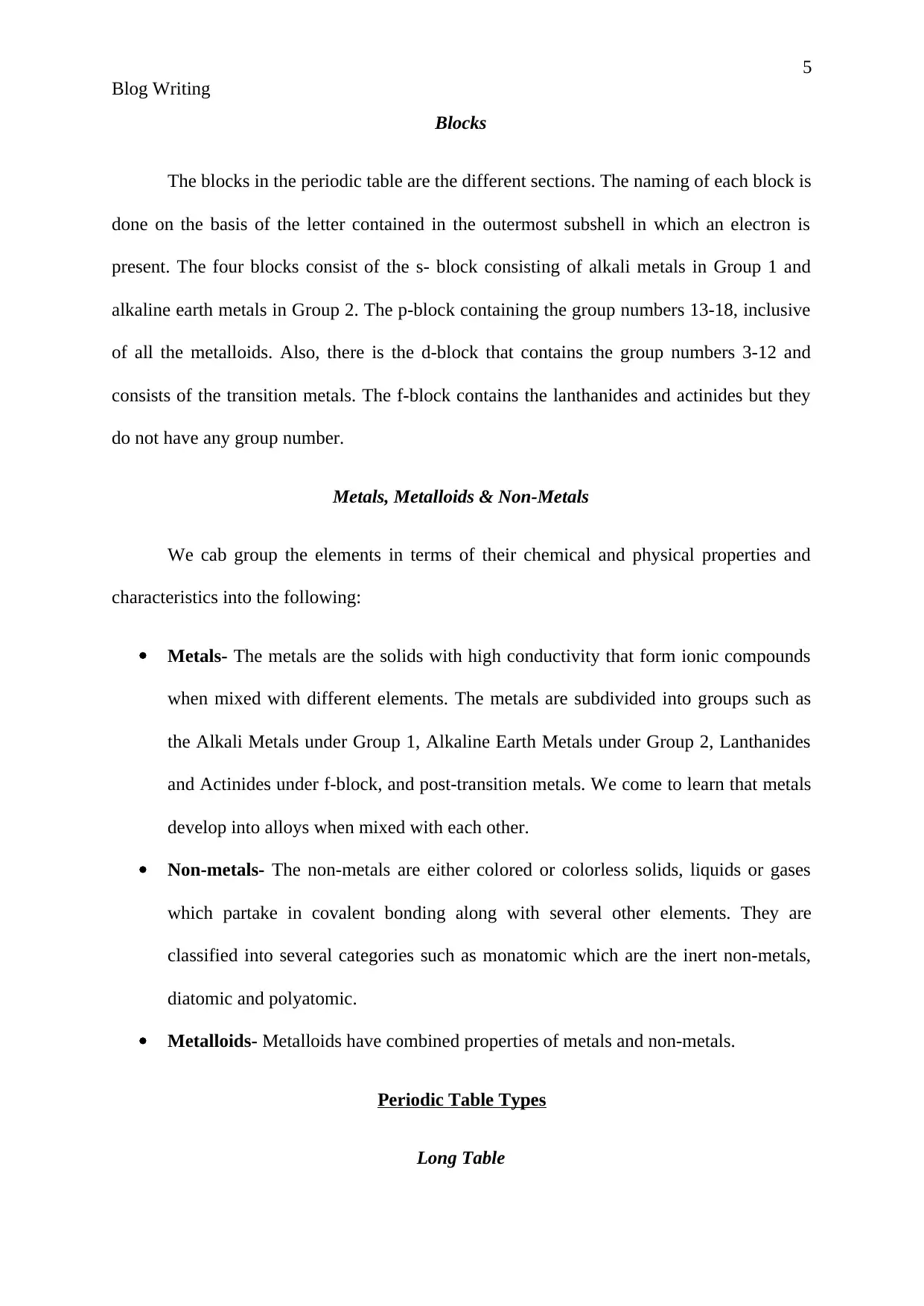
5
Blog Writing
Blocks
The blocks in the periodic table are the different sections. The naming of each block is
done on the basis of the letter contained in the outermost subshell in which an electron is
present. The four blocks consist of the s- block consisting of alkali metals in Group 1 and
alkaline earth metals in Group 2. The p-block containing the group numbers 13-18, inclusive
of all the metalloids. Also, there is the d-block that contains the group numbers 3-12 and
consists of the transition metals. The f-block contains the lanthanides and actinides but they
do not have any group number.
Metals, Metalloids & Non-Metals
We cab group the elements in terms of their chemical and physical properties and
characteristics into the following:
Metals- The metals are the solids with high conductivity that form ionic compounds
when mixed with different elements. The metals are subdivided into groups such as
the Alkali Metals under Group 1, Alkaline Earth Metals under Group 2, Lanthanides
and Actinides under f-block, and post-transition metals. We come to learn that metals
develop into alloys when mixed with each other.
Non-metals- The non-metals are either colored or colorless solids, liquids or gases
which partake in covalent bonding along with several other elements. They are
classified into several categories such as monatomic which are the inert non-metals,
diatomic and polyatomic.
Metalloids- Metalloids have combined properties of metals and non-metals.
Periodic Table Types
Long Table
Blog Writing
Blocks
The blocks in the periodic table are the different sections. The naming of each block is
done on the basis of the letter contained in the outermost subshell in which an electron is
present. The four blocks consist of the s- block consisting of alkali metals in Group 1 and
alkaline earth metals in Group 2. The p-block containing the group numbers 13-18, inclusive
of all the metalloids. Also, there is the d-block that contains the group numbers 3-12 and
consists of the transition metals. The f-block contains the lanthanides and actinides but they
do not have any group number.
Metals, Metalloids & Non-Metals
We cab group the elements in terms of their chemical and physical properties and
characteristics into the following:
Metals- The metals are the solids with high conductivity that form ionic compounds
when mixed with different elements. The metals are subdivided into groups such as
the Alkali Metals under Group 1, Alkaline Earth Metals under Group 2, Lanthanides
and Actinides under f-block, and post-transition metals. We come to learn that metals
develop into alloys when mixed with each other.
Non-metals- The non-metals are either colored or colorless solids, liquids or gases
which partake in covalent bonding along with several other elements. They are
classified into several categories such as monatomic which are the inert non-metals,
diatomic and polyatomic.
Metalloids- Metalloids have combined properties of metals and non-metals.
Periodic Table Types
Long Table
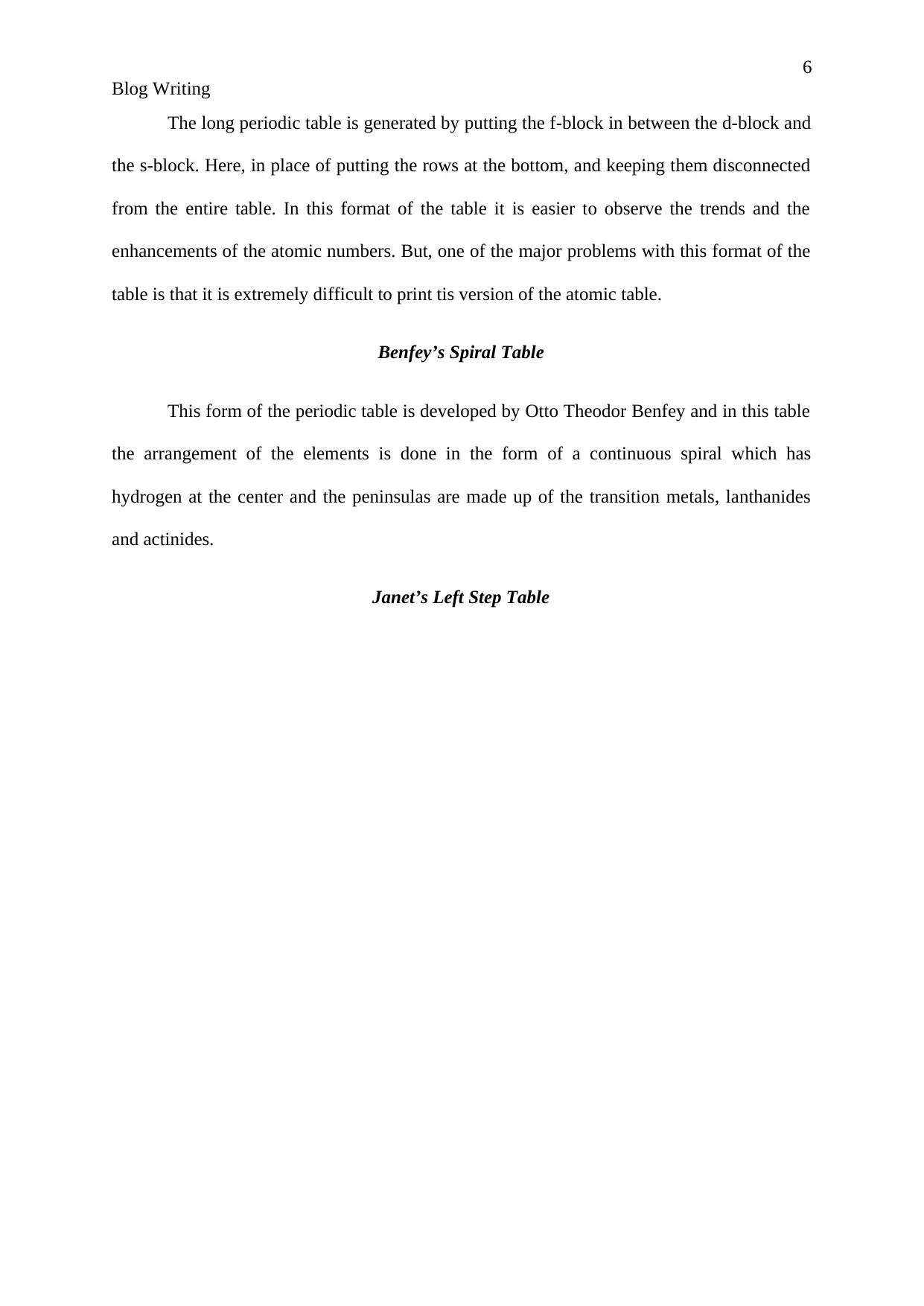
6
Blog Writing
The long periodic table is generated by putting the f-block in between the d-block and
the s-block. Here, in place of putting the rows at the bottom, and keeping them disconnected
from the entire table. In this format of the table it is easier to observe the trends and the
enhancements of the atomic numbers. But, one of the major problems with this format of the
table is that it is extremely difficult to print tis version of the atomic table.
Benfey’s Spiral Table
This form of the periodic table is developed by Otto Theodor Benfey and in this table
the arrangement of the elements is done in the form of a continuous spiral which has
hydrogen at the center and the peninsulas are made up of the transition metals, lanthanides
and actinides.
Janet’s Left Step Table
Blog Writing
The long periodic table is generated by putting the f-block in between the d-block and
the s-block. Here, in place of putting the rows at the bottom, and keeping them disconnected
from the entire table. In this format of the table it is easier to observe the trends and the
enhancements of the atomic numbers. But, one of the major problems with this format of the
table is that it is extremely difficult to print tis version of the atomic table.
Benfey’s Spiral Table
This form of the periodic table is developed by Otto Theodor Benfey and in this table
the arrangement of the elements is done in the form of a continuous spiral which has
hydrogen at the center and the peninsulas are made up of the transition metals, lanthanides
and actinides.
Janet’s Left Step Table
⊘ This is a preview!⊘
Do you want full access?
Subscribe today to unlock all pages.

Trusted by 1+ million students worldwide
1 out of 6
Your All-in-One AI-Powered Toolkit for Academic Success.
+13062052269
info@desklib.com
Available 24*7 on WhatsApp / Email
![[object Object]](/_next/static/media/star-bottom.7253800d.svg)
Unlock your academic potential
Copyright © 2020–2025 A2Z Services. All Rights Reserved. Developed and managed by ZUCOL.


